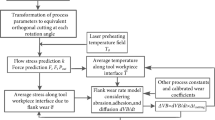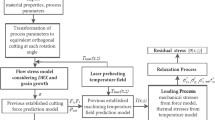Abstract
This manuscript proposes an inverse analysis method for the machined surface roughness in laser-assisted milling on Inconel 718. The method solves the forward problem considering the tool profile and the elastic recovery of machined surface and applies the variance-based recursive method to guide the updating mechanism of process parameters to match the measurements. Subsequently, the inverse analysis identifies four process parameters of feed per tooth, tool tip radius, minimum cutting thickness, and tool tip angle, and finds the optimal solution for target performance, the surface roughness. The measurements are collected under the single beam coaxial laser-assisted milling spindle. The proposed modified Kalman filter algorithm introduces the gain coefficient G when updating the process parameters to improve robustness and accuracy. The inverse analysis is conducted on all measurements, and the average error of target performance is 0.460% when the laser is on and 0.394% when the laser is off. The average difference of process parameters is less than 5%, and the selection process is done in 50 loops within a minute. Therefore, the proposed inverse analysis model is robust, adaptive to different initial guesses and measurements, highly accurate, and saves computation time.
Similar content being viewed by others
Abbreviations
- r t :
-
tool tip radius
- α e :
-
tool tip angle
- f z :
-
feed per tooth
- f :
-
rotation angle
- i :
-
number of revolution
- R t :
-
tool radius
- t min :
-
minimum cutting thickness
- t c :
-
actual cutting thickness
- Ra :
-
arithmetic average surface roughness
- X i :
-
length of each gap between two revolutions in feed direction
- \({\bar z_i}\) :
-
the arithmetical mean deviation between 0 and Zmax in each section
- X n :
-
process parameters after nth loop
- Ra exp R :
-
surface roughness measured from experiments
- G :
-
gain coefficient
- K n :
-
Kalman gain matrix
- P n :
-
simulation covariance matrix
- R :
-
error covariance matrix
References
Muñoz-Escalona, P., and Maropoulos, P. G., “A Geometrical Model for Surface Roughness Prediction when Face Milling Al 7075-T7351 with Square Insert Tools,” Journal of Manufacturing Systems, Vol. 36, pp. 216–223, 2015.
Hao, Y. and Liu, Y., “Analysis of Milling Surface Roughness Prediction for Thin-Walled Parts with Curved Surface,” The International Journal of Advanced Manufacturing Technology, Vol. 93, Nos. 5–8, pp. 2289–2297, 2017.
Lu, X., Zhang, H., Jia, Z., Feng, Y., and Liang, S. Y., “Floor Surface Roughness Model Considering Tool Vibration in the Process of Micro-Milling,” The International Journal of Advanced Manufacturing Technology, Vol. 94, Nos. 9–12, pp. 4415–4425, 2018.
Yuan, Z., Zhou, M., and Dong, S., “Effect of Diamond Tool Sharpness on Minimum Cutting Thickness and Cutting Surface Integrity in Ultraprecision Machining,” Journal of Materials Processing Technology, Vol. 62, No. 4, pp. 327–330, 1996.
Son, S. M., Lim, H. S., and Ahn, J. H., “Effects of the Friction Coefficient on the Minimum Cutting Thickness in Micro Cutting,” International Journal of Machine Tools and Manufacture, Vol. 45, Nos. 4–5, pp. 529–535, 2005.
Wu, J. H. and Liu, Z. Q., “Modeling the Minimum Chip Thickness in Orthogonal Micro-Cutting Based on Plastic Strain Gradient,” Advanced Materials Research, Vols. 203–208, pp. 203–208, 2009.
Zhanqiang, L., Zhenyu, S., and Yi, W., “Definition and Determination of the Minimum Uncut Chip Thickness of Microcutting,” The International Journal of Advanced Manufacturing Technology, Vol. 69, Nos. 5–8, pp. 1219–1232, 2013.
Wang, X. B., Li, D., Chen, N., and Chen, M. J., “The Minimum Cutting Thickness in Milling Process Simulation Analysis,” Materials Science Forum, Vols. 800–801, pp. 264–268, 2014.
Agmell, M., Ahadi, A., and Ståhl, J.-E., “Identification of Plasticity Constants from Orthogonal Cutting and Inverse Analysis,” Mechanics of Materials, Vol. 77, pp. 43–51, 2014.
Cui, M., Duan, W.-W., and Gao, X.-W., “A New Inverse Analysis Method Based on a Relaxation Factor Optimization Technique for Solving Transient Nonlinear Inverse Heat Conduction Problems,” International Journal of Heat and Mass Transfer, Vol. 90, pp. 491–498, 2015.
Denkena, B., Grove, T., Dittrich, M.-A., Niederwestberg, D., and Lahres, M., “Inverse Determination of Constitutive Equations and Cutting Force Modelling for Complex Tools Using Oxley’s Predictive Machining Theory,” Procedia CIRP, Vol. 31, pp. 405–410, 2015.
Xie, T., He, Y.-L., Tong, Z.-X., Yan, W.-X., and Xie, X.-Q., “An Inverse Analysis to Estimate the Endothermic Reaction Parameters and Physical Properties of Aerogel Insulating Material,” Applied Thermal Engineering, Vol. 87, pp. 214–224, 2015.
Mohebbi, F. and Sellier, M., “Estimation of Thermal Conductivity, Heat Transfer Coefficient, and Heat Flux Using a Three Dimensional Inverse Analysis,” International Journal of Thermal Sciences, Vol. 99, pp. 258–270, 2016.
De Bono, D. M., London, T., Baker, M., and Whiting, M. J., “A Robust Inverse Analysis Method to Estimate the Local Tensile Properties of Heterogeneous Materials from Nano-Indentation Data,” International Journal of Mechanical Sciences, Vol. 123, pp. 162–176, 2017.
Feng, Y., Lu, Y.-T., Lin, Y.-F., Hung, T.-P., Hsu, F.-C., et al., “Inverse Analysis of the Cutting Force in Laser-Assisted Milling on Inconel 718,” The International Journal of Advanced Manufacturing Technology, Vol. 96, Nos. 1–4, pp. 905–914, 2018.
Author information
Authors and Affiliations
Corresponding author
Additional information
Yixuan Feng Ph.D. candidate in the George W. Woodruff School of Mechanical Engineering, Georgia Institute of Technology. His research interest is laser-assisted milling.
Tsung-Pin Hung Assistant Professor in the Department of Mechanical Engineering, Cheng Shiu University. His research interest is laser-assisted machining.
Yu-Ting Lu Senior researcher in Metal Industries Research and Development Centre. His research interest is precision machining.
Yu-Fu Lin Senior researcher in Metal Industries Research and Development Centre. His research interest is precision machining and multi-axis milling.
Fu-Chuan Hsu Senior research director in Metal Industries Research and Development Centre. His research interest is electrical discharge machining.
Chiu-Feng Lin CEO of Metal Industries Research and Development Centre. His research interest is precision machining.
Ying-Cheng Lu CTO of Metal Industries Research and Development Centre. His research interest is precision machining.
Xiaohong Lu Associate Professor in the School of Mechanical Engineering, Dalian University of Technology. Her research interest is micro-milling Inconel 718.
Steven Y. Liang Professor in the George W. Woodruff School of Mechanical Engineering, Georgia Institute of Technology. His research interest is modeling, monitoring, and control of advanced manufacturing processes and equipment.
Rights and permissions
About this article
Cite this article
Feng, Y., Hung, TP., Lu, YT. et al. Inverse Analysis of Inconel 718 Laser-Assisted Milling to Achieve Machined Surface Roughness. Int. J. Precis. Eng. Manuf. 19, 1611–1618 (2018). https://doi.org/10.1007/s12541-018-0188-7
Received:
Revised:
Accepted:
Published:
Issue Date:
DOI: https://doi.org/10.1007/s12541-018-0188-7




